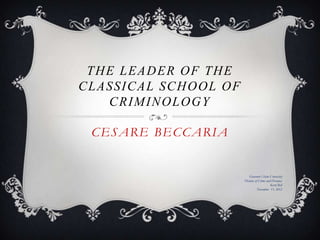
Leader of the Classical School of Criminology: Cesare Beccaria (1738-1794
- 1. THE LEADER OF THE CL A S S I C A L S C H O O L O F CRIMINOLOGY C ES A R E B E C C A R I A Governor’s State University Theories of Crime and Deviance Kerry Bell November 13, 2012
- 2. CESARE BONESANA, MARCHESE BECCARIA, 1738-1794
- 3. CLASSICAL SCHOOL OF CRIMINOLOGY In the 18th Century, Beccaria was the lead figure to lead the cause to reform the criminal justice system. As a scholar, he was not educated as criminal justice major but as a mathematician and economist. His thoughts of reform led to great ideas for changing the brutal way the law treated the common people. The law had the power to inflict torture, beat, hide the offender in secrecy, and even put to death (Lilly, pg. 21). Beccaria wanted the law or legislation to treat citizens with humane justice and have a purpose of preventing crime (Lilly, pg. 22). It was “better to prevent crimes than to punish those who commit them” ( Lilly, pg. 22).
- 4. FACT.. Alessandro Verri (1741-1816)(About Milan, n.d.), Beccaria’s close friend and head of the protectors of inmates in Milan, Italy, inspired Beccaria to write an essay based on prison conditions and how prisoners are treated. This essay was published anonymously due to fear of backlash from the government. This essay or later, book was called “On Crimes and Punishments” (Lilly, pg. 21).
- 5. FACTS.. The book On Crimes and Punishment (Lorenzo Da Ponte Italian Library, 2009), which was published in 1764, focused on changing the criminal justice system back in the late 1700’s. To Beccaria’s surprise, the government did accept and receive the book very well and considered the changes highlighted in the book. It was at that point, Beccaria revealed himself as the author. By the year 1767, after several revisions, the book was finally translated into English. Beccaria did not believe in capital punishment but he did believe in the punishment fitting the crime ( Lilly, pg.21).
- 6. FINAL THOUGHTS… The theory of punishment being a deterrence and used to prevent offenders from committing additional crimes comes from Beccaria’s book On Crimes and Punishment. This concept can still be applied today towards some punishment for offenders and is still being used today in the criminal justice field ( Lilly, pg. 22). Beccaria’s use of theory for explaining crime and how it should affect the people it govern, helped governments establish a ground work for guidelines to be used by the police and for criminal procedures to follow ( Lilly, pg. 20). Credit must be given to the classical school for discussing the thought process a criminal took to perform an act of crime. What motivates someone to commit crime? If crime is committed, the punishment should justify the crime without applying an excessive amount of punishment (Lilly, pg.21). Lastly, a wonderful fact most of us can appreciate is The U.S. Constitution was inspired by the ideas of Beccaria and the Classical school defining the rights of an offender and the government within the criminal law (Lilly, pg. 22).
- 7. REFERENCES About Milan.com .Famous People Of Milan. Retrieved from http://www.aboutmilan.com/milanese-famous-people.html. n.d. Anonymous. Internet Encyclopedia Of Philosophy Cesare Beccaria (1738-1794). Retrieved from http://www.iep.utm.edu/beccaria/11 April 2001 Coleman, C. & Norris, C., (2000) Introducing Criminology (Cullompton: Willan Publishing). Image http://suite101.com/article/positivist-criminology-a201231 Lilly, J. Robert , F. T. & Ball, R. A. (2011) Criminological Theory: Context and consequences ( 5th Edition) Sage Publications Lorenzo Da Ponte Italian Library, image. http://www.lpil.info/2008/05/29/on-crimes-and-punishments-and-other-writings/. May 2009 Roland, Jon. Constitution Society. Of Crimes and Punishments . Retrieved from http://www.constitution.org/cb/crim_pun.htm 18 August 2012
Editor's Notes
- References